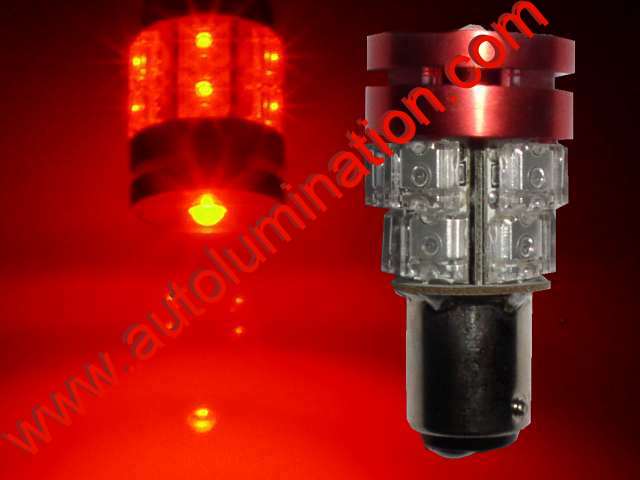Quote:
I have a white single filament P21W bulb behind a red brake light lamp. This bulb is only used for braking (parking/position lights are separate). If I were to replace this bulb with Luxeon LED, which one should I get? The 1156-LX3 red?
You will want a red LED behind your (red) lens, as that will give you roughly 3x the light of a white LED (of the same nominal light output) behind the red lens. The reason for this, is that turning "white light" into colored light, is done by "throwing away" any light not of the correct color (which "wastes" a lot of your total light). But when you put a colored light (for example, due to a colored LED) behind the same color lens, you get almost all the light going through the lens as "useful light"). So your choice of LED color (red) is the correct choice.
The big question in my mind is, would that "bulb" fit your existing P21W bulb socket? Assuming you (like most of us) have a 12v-15v electrical system powering the light, the only "unknown" is the bulb base (i.e. will it physically fit?). Since the 1156-LX3 is (apparently) designed to replace a (12v) 1156 bulb (or any other 12v car light that physically fits in a 1156 socket), the real question is: Is the base of your P21W physically identical to the base of a cheap 1156 bulb? If so, than that choice of LED will probably work for you (as a "drop in replacement"). But if the bulb base is not identical to a 1156 bulb base, you would likely have to swap your car socket (to a standard 1156 base) before using that LED module.
I did a quick google of P21W, and got a wide variety of descriptions. So it looks like P21W doesn't uniquely describe one bulb, but instead describes a family of bulbs?
Which makes it a little unclear about what fits your particular bulb base. You might try the Silvania web site, to try to identify the exact bulbs in your car:
http://www.sylvania.com/ConsumerProducts/AutomotiveLighting/LampReplacementGuide/
Or, (if the above bulb cross-reference) doesn't give you some useful info, you might just waste a buck or two to buy a stock 1156 bulb as a test. If the stock (cheap, incandescent) 1156 bulb works in your application, it's very likely that your choice of LED module will work as well (as that LED module appears to be designed to mimic a stock 1156 car bulb). OTOH if the cheap stock 1156 doesn't work (as a short-term test), than don't bother wasting your money on the LED module (as if the stock 1156 doesn't fit, then it's likely that the LED module won't fit either)!
Quote:
Also, anyone using these particular ones?
I'm not using that exact module, but I do use a related one. On my CRX, I've currently got the "1157-LX3" (dual brightness) Luxeon modules for my combo brake/tail lights. My experience with them has been favorable overall. They seem to be very noticeably brighter (effective light going out the red car lens) than the stock 1157 bulbs I was replacing, and the light is a much more "pure" red as well. And the "turning on" (when I step on the brake) seems to happen almost instantly (unlike a normal incandescent bulb, which will take a fraction of a second to "warm up"). Overall, I really like my LED "upgrades" (except for the initial cost to purchase them, of course). However, with all the variables involved with LEDs, YMMV.
Quote:
If it's not going to be as bright as a regular P21W bulb, then I won't bother.
I have no idea how bright a P21W bulb is. Is it about the same brightness as a stock 1156 bulb?
If so, than I would expect the Luxeon modules to be noticeably brighter (based upon my prior experience with other closely related Luxeon LED lights).
In fact, the Luxeon modules I'm using appear (to my naked eye) to produce about twice the effective light (through the car lens) than the stock 1157 bulbs did. So the extra brightness was very noticeable when I looked. However, since I don't have a "light meter", this is only a rough subjective observation on my part (so I'm not sure how close my subjective observations are, as I didn't have any test equipment to check).
NOTE:
If you have no idea how bright a P21W bulb is, than the (previously mentioned) suggestion of buying a cheap (one or two dollar) 1156 bulb as a "test" only (to see if the 1156 bulb will physically fit, and roughly how the light outputs compare) might be worth while, before deciding if you will get the LEDs.








